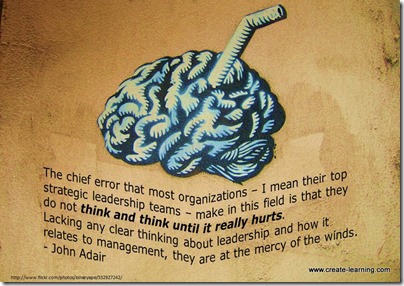An earlier post listed the 7 Principles of Leadership Development in no specific order of importance:
- Necessary Skilled-Knowledge
- Selection
- Using Existing Employees as Mentors
- Education for Leadership
- Strategy for Leadership Development
- The Chief Executive
- The Chance to Lead
Exploring lessons learned and how an organization and I developed a leadership development process for high-potential employees.

Effective leadership development is too important for the present and future success of a business to be left to the human resources department. It is a core activity to grow leaders. – John Adair
Strategy for Leadership Development
Now that we have an idea of the needed skilled-knowledge, selected who should be involved, and began the development of using existing employees as mentors in the leadership development process, need to confirm and share the strategy for leadership development was the focus.
Strategy within leadership development is a focus on the whole of the organization and using systems-thinking to see how the whole is greater than the sum of its parts.
Strategy for leadership development has to focus on 3 Pillars:
- Long-Term – this leadership-development program was in some sense about the needs of today – and – we needed to identify and build the long-term tomorrow of the employees and company.
- Importance – many urgent items will (and did) pop up during the leadership development. The need to keep this an important goal, and to focus on metrics based on the long-term needs – held the importance high.
- Multi-Component – consistent checking and knowledge that many pieces are required to make this leadership development effective, needed cross-functional-working teams to develop and keep the strategy.
We used the framing questions below to discuss, question, tear down, rebuild and critically consider steps we have already put in place, and future steps.
- What are the hidden assumptions behind our identified Skilled-Knowledge, those selected to be in the process, the mentors we chose, and our method of education?
- Is there a clear, pragmatic philosophy in what we are doing/ looking to do? Can you explain it in simple and concrete terms?
- Are we all clear about what leadership is and how it relates to management within this company? In the future state of the company?
- Is our strategy aligned with the choice we made that no one should be given a leadership role without training, education, and preparation for it?
- How will we decide on costs, long term vs. short term savings and investments for the leadership-development process? Who is responsible for ensuring that our investments are being returned and what we are training people to do they are doing?
- Are the people we chose and trained as mentors being evaluated? And are they completing the level or work and training expected? Are the leadership-mentees applying and showing competence through the mentoring?
- How is the leadership-development strategy being evaluated? What are the progress markers? Have we shared these with everyone?
- Is too much of our resources being used on too few people at the top of the company?
- How is this leadership-development process strategy going to show how we improved the identification of leadership potential in our selection and promotion process?
- What ‘research and development’ is embedded in the strategy?
We found that having this strategy talk, and several meetings, forced the Management + Human Resources + Leadership Development Team to think and think until it really hurts.

We completed (somewhat) answering the questions above, forming a 1 page ‘Strategy for Leadership Development’ document that contained defined terms, measurable milestones and evaluation points. Sharing this document with all the staff helped in getting more people onboard and making the Leadership-Development Process something that people were proud to be a part of.
Prepared now with a Strategy for Leadership-Development, the needed Skilled-Knowledge, Selection Process, Managers as Mentors and how we will Educate for Leadership the ~150 potential managerial-leaders, we kept on focusing on what is working and what the next steps will be…
Reference: John Adair; How to Grow Leaders

